
Dumping of solid wastes / empty containers scrap metals, glass bottles, plastic containers; these lenders the environment to be useless for agricultural purposes;
Excessive use of inorganic fertilizer on the farm; lowers the organic content of the soil reducing the water retention ability; decreases organic matter content making the soil uninhabitable by micro and macro organisms in the soil; making the soil to reduce soil fertility;
Excessive use of pesticides; this kills intended beneficial soil organisms both micro and macro organisms resulting to reduction in soil fertility;
Agrochemicals like pesticides / fungicides / herbicides alters the soil pH; resulting in poor plant growth;
Continuous use of chemicals in the farms / aerosols / agrochemicals precipitate in the soil and are taken up by plants; their concentration build up in the plants increasing to toxic levels;
Heavy metals contained in agrochemicals in the soil are not used by plants hence accumulating in the soil; and eventually make it inhabitable by micro-organisms;
Air pollutant like sulphur (IV) oxide and nitrogen (IV) oxide forms acid rain; the acid rain alters the soil pH causing poor growth of plants;
Radioactive wastes dumped in the soil; cause death of micro-organisms in the soil;
Oil effluent in the soil; they kill soil organisms / prevent root from taking oxygen and absorption of water;
sharon kalunda answered the question on May 24, 2019 at 09:10
- Describe the way by which terrestrial plants are adapted to living in arid and semi-arid ecosystems.(Solved)
Describe the way by which terrestrial plants are adapted to living in arid and semi-arid ecosystems.
Date posted: May 24, 2019. Answers (1)
- Describe the adaptations of wind pollinated flowers.(Solved)
Describe the adaptations of wind pollinated flowers.
Date posted: May 24, 2019. Answers (1)
- The diagram below represents one of the joints in the mammalian skeleton.
a) Name the type of joint shown in the diagram.
b) Name the parts labelled...(Solved)
The diagram below represents one of the joints in the mammalian skeleton.
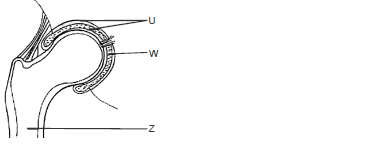
a) Name the type of joint shown in the diagram.
b) Name the parts labelled Z and U
c) Name two parts at the body where this type of joint is found.
d) State the functions of the fluid found in W.
e) Name the structure which attaches muscles to the bones at a joint.
Date posted: May 24, 2019. Answers (1)
- The diagram below represent a seedling.
a) Name the structure labelled B
b) State the functions of the parts labelled A and C
c) Name the...(Solved)
The diagram below represent a seedling.
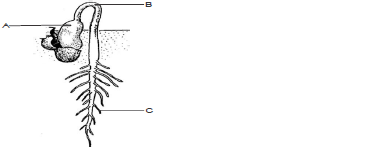
a) Name the structure labelled B
b) State the functions of the parts labelled A and C
c) Name the type of germination exhibited by the seedling.
d) State three conditions within the seed necessary for germination.
e) What is the importance of optimum temperature in seed germination ?
Date posted: May 24, 2019. Answers (1)
- The diagram below represents a transverse section of a young stem.
a) Name the parts labelled A and C on the diagram.
b) State the functions...(Solved)
The diagram below represents a transverse section of a young stem.

a) Name the parts labelled A and C on the diagram.
b) State the functions of the parts labelled B, D and E
c) List three differences between the section shown above and one that would be obtained from the
root of the same plant.
Date posted: May 24, 2019. Answers (1)
- State the function of goblet cells.(Solved)
State the function of goblet cells.
Date posted: May 24, 2019. Answers (1)
- The diagram below is a cross section through a part of human ileum.
a) i) Identify the structure drawn above.
ii) State the significance of the...(Solved)
The diagram below is a cross section through a part of human ileum.
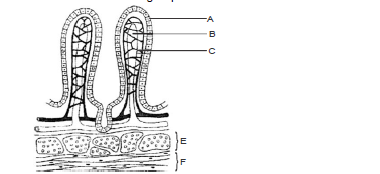
a) i) Identify the structure drawn above.
ii) State the significance of the structure shown above.
b) Name the parts labelled A, B and C
c) Give the functions of the part labelled B and C.
Date posted: May 24, 2019. Answers (1)
- Give two reasons why Drosophila melanogaster (Fruit fly) are considered suitable organisms for
use in genetic experiments.(Solved)
Give two reasons why Drosophila melanogaster (Fruit fly) are considered suitable organisms for
use in genetic experiments.
Date posted: May 24, 2019. Answers (1)
- Where does glycolysis take place in a cell ?(Solved)
Where does glycolysis take place in a cell ?
Date posted: May 24, 2019. Answers (1)
- At what stage do chromatids separate during meiosis ?(Solved)
At what stage do chromatids separate during meiosis ?
Date posted: May 24, 2019. Answers (1)
- Akol observed and drew an amoeba using a light microscope. If the total magnification of the amoeba was X450 and that of the objective lens...(Solved)
Akol observed and drew an amoeba using a light microscope. If the total magnification of the amoeba was X450 and that of the objective lens was X30. What was the magnification of the eyepiece lens ? Show your working.
Date posted: May 24, 2019. Answers (1)
- Describe an experiment to investigate the effects of unilateral source of light on growth of seedlings.(Solved)
Describe an experiment to investigate the effects of unilateral source of light on growth of seedlings.
Date posted: May 24, 2019. Answers (1)
- In an experiment, 900 viable seeds of a certain plant species were divided into groups of 100 seeds each. Each group of
seeds was placed at...(Solved)
In an experiment, 900 viable seeds of a certain plant species were divided into groups of 100 seeds each. Each group of
seeds was placed at different temperatures but same conditions of air and moisture. The percent germination was
determined after 10 days. The table below shows percent germination at the various temperatures.

a) Using a suitable scale, draw a graph of percent germination against temperature.
b) Account for percent germination at :
i) 50°
ii) 30°C
iii) 40°C
c) Explain the role played by each of the following factors in the germination of seeds.
i) Water.
ii) Air.
Date posted: May 24, 2019. Answers (1)
- State TWO features of the endodermis.(Solved)
State TWO features of the endodermis.
Date posted: May 24, 2019. Answers (1)
- The diagram below represents phloem tissue from the stem of a plant.
i) Name the structure labelled A.
ii) State TWO substances transported in the phloem....(Solved)
The diagram below represents phloem tissue from the stem of a plant.
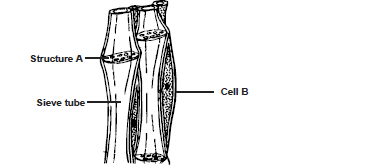
i) Name the structure labelled A.
ii) State TWO substances transported in the phloem.
iii) Give the function of cell B.
Date posted: May 24, 2019. Answers (1)
- Three sterilized petri dishes I, II and III were half filled with sterilized nutrient agar jelly and then treated as shown below.
The petri dishes were...(Solved)
Three sterilized petri dishes I, II and III were half filled with sterilized nutrient agar jelly and then treated as shown below.
The petri dishes were then kept in an oven at 36°C. After 2 days the three petri dishes were flooded with iodine solution.

a) Yellow spots were noted in set up I and II while set up III turned blue black.
i) What was the importance of sterilization in the experiment?
ii) Mention TWO ways by which sterilization could have been achieved.
b) Explain the results obtained in each of the three petri dishes after 2 days.
Date posted: May 24, 2019. Answers (1)
- 50cm³ of 10% glucose solution was boiled and allowed to cool. The solution was then poured into a vacuum flask and about
5cm³ of groundnut oil...(Solved)
50cm³ of 10% glucose solution was boiled and allowed to cool. The solution was then poured into a vacuum flask and about
5cm³ of groundnut oil added to it. 10% yeast solution was introduced into the glucose solution using a pipette. A
thermometer was placed in the flask and supported with a cotton wool plug. A second flask was set up as above, but
containing cooled boiled water instead of 10% glucose solution. The temperature of each flask was recorded at the
beginning and thereafter at hourly intervals for several hours.
a) Why was a vacuum flask used in this experiment?
b) What was the purpose of the second flask?
c) Write a word equation to summarize the reaction that took place in the first flask.
d) Why was groundnut oil added to the flask?
e) Why was it necessary to boil the glucose and the water before they were poured into the flask?
Date posted: May 24, 2019. Answers (1)
- Distinguish between obligate and facultative anaerobes.(Solved)
Distinguish between obligate and facultative anaerobes.
Date posted: May 24, 2019. Answers (1)
- Haemophilia is a bleeders disease. The disease is caused by a recessive gene which is carried in the X chromosome. XH
stands for normal gene whereas...(Solved)
Haemophilia is a bleeders disease. The disease is caused by a recessive gene which is carried in the X chromosome. XH
stands for normal gene whereas Xh stands for haemophilia gene. The figure below shows a family tree.

a) What is the genotype of
i) Mother
ii) Son marked 2
iii) Daughter marked 1
b) If the haemophilia son marries a girl who has no history of haemophilia in her family, what will be the genotype of the
offspring ? (Show your working)
Date posted: May 24, 2019. Answers (1)
- The diagram below represents recycling of nutrients in a certain ecosystem.
a) Name the trophic level represented by M.
b) Name the processes represented by. I,II,III...(Solved)
The diagram below represents recycling of nutrients in a certain ecosystem.
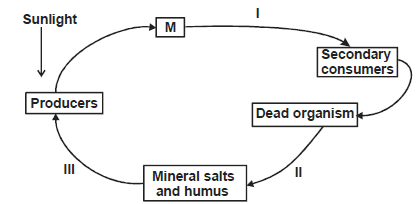
a) Name the trophic level represented by M.
b) Name the processes represented by. I,II,III
c) Name the organisms involved in process II.
d) What would happen within the ecosystem if all secondary consumers were eliminated?
Date posted: May 24, 2019. Answers (1)